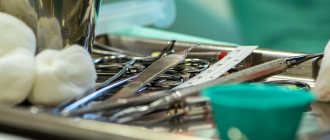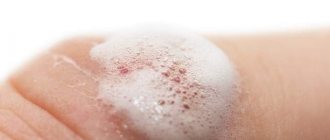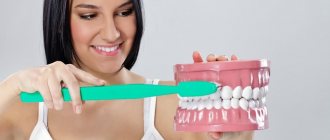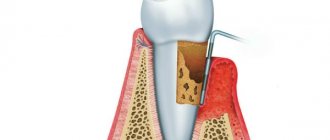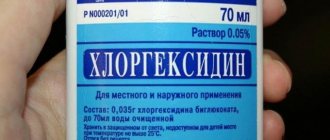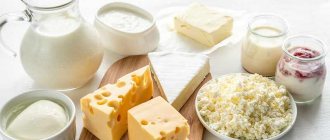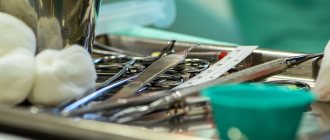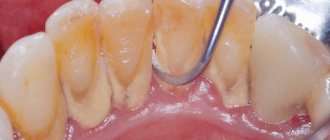Features of professional cleaning
Modern methods of removing tartar are a safe and comfortable procedure. Even pregnant women can undergo professional cleaning.
Teeth brushing is a virtually painless procedure; in very rare cases, the patient is given application anesthesia. Removal of tartar and plaque is carried out in several stages:
- Stone removal.
The main stage of professional teeth cleaning is the removal of tartar under the influence of ultrasound. The stone easily comes off the surface of the teeth and is cleaned off. - Cleaning using an Air Flow device.
Under pressure, abrasive particles are delivered to the tooth surface from a special apparatus with a stream of water. The particles not only clean, but also whiten the enamel, making it 1-2 shades brighter. - Polishing of hard tooth tissues.
After brushing, the surface of the enamel becomes slightly rough, and if left in this condition, tartar will very quickly begin to form on the surface of the teeth. To prevent this from happening, teeth are treated using special rubber discs and brushes. After polishing, the enamel becomes smooth, which protects it from negative influences. - Antiseptic treatment.
Prevention of periodontal inflammation during professional teeth cleaning is antiseptic treatment of the oral cavity. The use of antiseptics will stop the spread of infection and avoid additional complications. - Fluoridation of teeth.
This stage of treatment is mandatory if the patient's enamel is weak, sensitive and prone to destruction. After cleaning, fluoride varnish is applied to the teeth, which helps strengthen the enamel. - Use of medicinal dressings.
In case of severe periodontal inflammation, bleeding or significant trauma to the gums that occurred during the removal of dental plaque, the doctor may decide to use therapeutic dressings. Dressings are prepared before use and may contain antibiotics, antiviral drugs, enzymes, antiseptics or sulfonamides.
Why is tartar dangerous?
Hard dental plaque is a conglomerate of complex composition, formed from microscopic food debris and iron and phosphorus compounds contained in saliva. In fact, the stone grows into the periodontium, and it is not possible to remove it on your own. First, a thick plaque forms on the teeth, which gradually hardens and turns into stone.
Dental plaque promotes the proliferation of pathogenic flora, resulting in caries, gingivitis, and periodontitis. A favorable environment causes rapid growth of pathogenic bacteria and further damage to the periodontium.
The main signs of the appearance of tartar include:
- noticeable stripes, dots, spots of brown (in shades) color on the enamel;
- unpleasant, “heavy” odor from the mouth;
- internal sensation of enamel roughness.
The smile takes on an unaesthetic appearance, and the smell forces the interlocutor to stay away.
It is especially important to monitor the condition of teeth and remove tartar in a timely manner for those who smoke and drink strong tea and coffee. In this case, nicotine and tannins enter into the process of stone formation - deposits form much faster and acquire a characteristic dark brown color.
Important. The end result of an irresponsible attitude towards tartar is tooth loss.
Causes of inflammation
Unpleasant sensations almost always occur after dental procedures. The main reason why inflammation occurs is the increased sensitivity of hard and soft tissues. Oral sensitivity can be an individual characteristic of the patient or a consequence of gingivitis, periodontitis, periodontal disease and other gum diseases. Often the cause of such problems is tartar.
Exacerbation of the pathology also provokes medical intervention, and after cleaning, gum inflammation intensifies. However, if you follow all the doctor’s recommendations, the unpleasant symptoms subside within a few hours or days.
The causes of gum inflammation after professional teeth cleaning can also be:
- enamel microcracks;
- caries;
- incorrectly selected toothpaste;
- toothbrush too hard;
- soft tissue injuries;
- mucosal lesions;
- inflammation of the gums;
- pulpitis;
- periodontitis.
Is it painful to remove subgingival calculus?
When cleaning stone in subgingival pockets, in most cases, mild pain occurs. This is explained by the fact that the stone is attached directly to the periodontium. Even a thin layer of enamel significantly reduces tooth sensitivity; it simply does not exist in the subgingival zone. Therefore, discomfort during the procedure is a completely reliable and expected phenomenon.
Subgingival stone must be removed, as it causes the development of putrefactive bacteria and contributes to the occurrence of caries and inflammatory diseases of the oral cavity.
Rehabilitation after cleaning
To prevent gum inflammation from starting after professional teeth cleaning, the patient should be attentive to himself and follow all the doctor’s recommendations regarding rehabilitation. Correct behavior and oral care will allow you to consolidate the results of cleaning for a long time, eliminate inflammation and prevent its complications.
What to do if your gums bleed during brushing
Treatment of bleeding gums during brushing can be medicinal and alternative; the use of traditional medicine is allowed. All methods combine well with each other, and combination therapy helps to achieve results faster. However, any type of treatment must be prescribed by a doctor. Only in this case will the increased bleeding of the gums go away without consequences or complications.
To treat bleeding gums, drugs with an antibacterial effect that relieve pain and inflammation are usually used:
- Ointments and gels;
- Special toothpastes;
- Irrigators with special solutions;
- Rinses based on medicinal herbs and plants.
Proper brushing of teeth
If bleeding during brushing is due to poor oral hygiene, your dentist should tell you how to properly brush your teeth without damaging the soft gum tissue.
Rules for safe and effective cleaning:
- Teeth should be brushed without applying strong pressure.
- You need to choose brushes with soft bristles.
- You cannot brush your teeth with longitudinal movements; you need to move the brush from the gum to the edge of the tooth.
Many people actively use dental floss to clean interdental spaces, but if used carelessly, the floss can easily damage soft tissues and lead to bleeding. An irrigator is considered a safer and more effective method than dental floss. A stream of water or an antibacterial solution will clean the interdental spaces without injury.
Ointments and gels for bleeding gums
Preparations in this series are applied to the problem area of the mucous membrane after rinsing the mouth. Ointments and gels are usually used twice a day, have a local effect, and enhance the effect of other medications.
To treat bleeding gums, dentists prescribe:
- Metrogil Denta. Antibacterial agent for external use with anti-inflammatory effect. Recommended for use for stomatitis, it stops the spread of infections after tooth extraction.
- Asepta. Available in gel form, it quickly relieves inflammation of the mucous membranes and gums. Propolis is used as the main medicinal component.
- Holisal. This gel works in three directions: relieves pain, relieves inflammation, and destroys germs. The drug is suitable for children and adults.
- Kamistad. The gel is available in two forms: for children and for adults. Used for oral pain relief, helps with bleeding and gingivitis.
- Elugel. A strong antiseptic, cleanses and disinfects mucous membranes without damage. Contraindications include the patient's hypersensitivity to chlorhexidine.
- Tin based gel Home Care. Has a hemostatic astringent effect.
Rinse with antibacterial solutions
To treat bleeding gums when brushing teeth, rinses with a healing and antibacterial effect are prescribed:
- Furacilin;
- Rotokan;
- Miramistin;
- Chlorhexidine;
- Soda or salt solutions;
- Romazulan;
- Stomatophyte;
- Chlorophyllipt (alcohol solution).
Non-medicinal products are used for preventive purposes:
- Listerine;
- Forest balm;
- Lakalut;
- Asepta Paradontal.
The effectiveness of therapeutic and preventive rinses increases if you use solutions through an irrigator. These devices operate in a gentle mode, the water flow is adjusted depending on the goals. The irrigator has a dual effect: it cleans the interdental space efficiently and stops bleeding gums.
Toothpastes
Special pastes will help relieve inflammation and eliminate bleeding while brushing your teeth:
- Parodontax;
- Splat Active;
- Lakalut;
- Asepta;
- Colgate Total Pro;
- Parodontol Active.
When choosing a suitable toothpaste, you need to remember that to combat bleeding, you need to use formulations without a whitening effect.
Treating bleeding gums at home
Let us immediately note that folk remedies are included in the treatment complex only as prescribed by a doctor. If gum bleeding is a one-time occurrence, for prevention you can rinse your mouth with decoctions based on:
- Yarrow;
- Chamomiles;
- Calendula;
- Oak bark.
To strengthen the gums, salt and soda solutions and propolis tincture are suitable.
Treatment of inflammation
If gum inflammation appears solely as a result of professional teeth cleaning, several simple ways can reduce the negative manifestations:
- Do not eat rough foods within 24 hours after cleansing.
- For 12 hours, exclude drinks that stain the enamel - coffee, wine, natural citrus juices.
- Immediately after cleansing, avoid drinking too hot or cold drinks for 2-3 hours.
- When you get home, immediately replace your old toothbrush with a new one and do not use it for more than 3 months.
- Visit your dentist every six months for an oral exam and professional cleaning.
If your gums hurt for more than a day after professional cleaning and the discomfort does not subside, it may be caused by some kind of complication. If you have a long-term pain attack, be sure to visit the dentist.
Before visiting a specialist, painful sensations can be relieved with the help of painkillers and anti-inflammatory drugs.
Why does pain occur?
Unpleasant sensations after brushing your teeth can be caused by a variety of reasons. The most common causes of pain are:
- sensitivity of enamel to toothpaste components;
- enamel microcracks;
- caries;
- inflammation of the gums;
- incorrectly selected toothbrush (too big or too hard);
- incorrect teeth brushing technique.
Often, pain after brushing your teeth is caused by the wrong toothpaste. Even the most expensive products may contain fragrances, which cause allergic reactions. In this case, try to choose a neutral product, without various unusual additives.
Very often, fluoride is an irritant to enamel. Dentists advise choosing a toothpaste without this substance or with a minimal amount of it.
For example, Asepta Active preventive toothpaste is suitable for gentle cleansing of the oral cavity. The product provides reliable protection of teeth and gums from bacteria and strengthens tooth enamel. The paste contains extracts of sage, St. John's wort and calendula, which have antimicrobial and anti-inflammatory effects. The active enzyme in the paste is papain, which breaks down the protein matrix of dental plaque, slows down the formation of dental plaque, and also helps dissolve pigmented plaque without damaging the enamel. Xylitol, which is part of the drug, protects teeth from caries, strengthens tooth enamel, and soothes gums.
Folk remedies for relieving gum pain
Simple folk recipes will also help relieve gum inflammation and soothe the tissues:
- Prepare a decoction of sage and chamomile by taking a tablespoon of the raw material and pouring a glass of boiling water over it. The herbs must be infused in a steam bath for 15-20 minutes, and then rinsed throughout the day. As a rule, the pain noticeably subsides after the third rinse.
- A solution of baking soda can quickly eliminate gum inflammation after professional teeth cleaning. It is enough to dissolve a teaspoon of baking soda in a glass of water and rinse your mouth with the mixture several times a day.
For acute inflammation of the gums, dentists advise using the unique ASEPTA gel with propolis. The product with the waste product of bees provides action in four directions: antimicrobial, anti-inflammatory, healing and analgesic.
We hope that gum inflammation after brushing your teeth will not torment you, and this hygiene procedure will become your usual care and a way to maintain a healthy, snow-white smile.
Sources:
- Report on clinical trials to determine/confirm the preventive properties of commercially produced personal oral hygiene products: mouth rinse "ASEPTA PARODONTAL" - Solution for irrigator." Doctor of Medical Sciences Professor, Honored Doctor of the Russian Federation, Head. Department of Preventive Dentistry S.B. Ulitovsky, doctor-researcher A.A. Leontiev First St. Petersburg State Medical University named after academician I.P. Pavlova, Department of Preventive Dentistry.
- Report on clinical trials of anti-inflammatory balm for gums "Asepta" adhesive, St. Petersburg State Medical University, 2007
- The role of anti-inflammatory rinse in the treatment of periodontal diseases (L.Yu. Orekhova, A.A. Leontyev, S.B. Ulitovsky) L.Yu. OREKHOVA, Doctor of Medical Sciences, Prof., Head of Department; A.A. LEONTIEV, dentist; S.B. ULITOVSKY, Doctor of Medical Sciences, Prof. Department of Therapeutic Dentistry of St. Petersburg State Medical University named after. acad. I. P. Pavlova
Contraindications
Despite the fact that the procedure is safe and recommended for most people, there are a number of contraindications:
- pregnancy (not an absolute contraindication, consult your doctor),
- tuberculosis,
- asthma,
- age up to 18 years,
- colds and infectious diseases,
- HIV,
- hepatitis,
- gastrointestinal diseases,
- the presence of implants or orthodontic structures,
- increased sensitivity of teeth.
The dentist will definitely inform you about all existing contraindications and carry out the procedure in accordance with the condition of your teeth.
Prevention
To avoid gum bleeding when brushing your teeth, dentists recommend following these rules:
- It is better to give up dental floss and choose brushes with soft and medium-hard bristles. The best option for oral care is a combination of a soft toothbrush, a special medicated paste, rinsing and cleaning with an irrigator. This method will effectively remove food debris from the oral cavity without damaging the mucous membrane.
- Take vitamins K and C. This will require a balanced diet or the inclusion of vitamin complexes in your daily diet.
- Compliance with personal hygiene rules. Proper brushing of teeth 2 times a day, regular preventive examination by the dentist.
- To prevent bleeding, it is better to use compounds with a therapeutic effect. It is recommended to change the brush every 3 months.
When your gums bleed, it is not only unpleasant, but also dangerous. The wounds can get infected, which can cause serious complications. Therefore, when the first symptoms appear, it is better to immediately consult a doctor.
Author of the article
